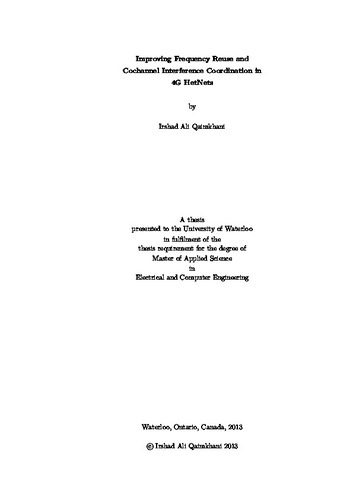| dc.contributor.author | Qaimkhani, Irshad Ali | |
| dc.date.accessioned | 2013-08-30 19:10:41 (GMT) | |
| dc.date.available | 2014-05-15 05:00:57 (GMT) | |
| dc.date.issued | 2013-08-30T19:10:41Z | |
| dc.date.submitted | 2013 | |
| dc.identifier.uri | http://hdl.handle.net/10012/7807 | |
| dc.description.abstract | This report describes my M.A.Sc. thesis research work. The emerging 4th generation
(4G) mobile systems and networks (so called 4G HetNets) are designed as multilayered cellular topology with a number of asymmetrically located, asymmetrically powered, self-organizing, and user-operated indoor small cell (e.g., pico/femto cells and WLANs) with a variety of cell architectures that are overlaid by a large cell (macro cell) with some or all interfering wireless links. These designs of 4G HetNets bring new challenges such as increased dynamics of user mobility and data traffic trespassing over the multi-layered cell boundaries. Traditional approaches of radio resource allocation and inter-cell (cochannel) interference management that are mostly centralized and static in the network core and are carried out pre-hand by the operator in 3G and lower cellular technologies, are liable to increased signaling overhead, latencies, complexities, and scalability issues and, thus, are not viable in case of 4G HetNets. In this thesis a comprehensive research study is carried out on improving the radio resource sharing and inter-cell interference management in 4G HetNets. The solution strategy exploits dynamic and adaptive channel allocation approaches such as dynamic and opportunistic spectrum access (DSA, OSA) techniques, through exploiting the spatiotemporal diversities among transmissions in orthogonal frequency division multiple access (OFDMA) based medium access in 4G HetNets.
In this regards, a novel framework named as Hybrid Radio Resource Sharing (HRRS) is introduced. HRRS comprises of these two functional modules: Cognitive Radio Resource Sharing (CRRS) and Proactive Link Adaptation (PLA) scheme. A dynamic switching algorithm enables CRRS and PLA modules to adaptively invoke according to whether orthogonal channelization is to be carried out exploiting the interweave channel allocation (ICA) approach or non-orthogonal channelization is to be carried out exploiting the underlay channel allocation (UCA) approach respectively when relevant conditions regarding the traffic demand and radio resource availability are met. Benefits of CRRS scheme are identified through simulative analysis in comparison to the legacy cochannel and dedicated channel deployments of femto cells respectively. The case study and numerical analysis for PLA scheme is carried out to understand the dynamics of threshold interference ranges as function of transmit powers of MBS and FBS, relative ranges of radio entities, and QoS requirement of services with the value realization of PLA scheme. | en |
| dc.language.iso | en | en |
| dc.publisher | University of Waterloo | en |
| dc.subject | Radio resource sharing | en |
| dc.subject | Interference coordination | en |
| dc.subject | OFDMA | en |
| dc.subject | 4G HetNets | en |
| dc.subject | Dynamic spectrum access | en |
| dc.subject | Opportunistic spectrum access | en |
| dc.title | Improving Frequency Reuse and Cochannel Interference Coordination in 4G HetNets | en |
| dc.type | Master Thesis | en |
| dc.pending | true | en |
| dc.subject.program | Electrical and Computer Engineering | en |
| dc.description.embargoterms | 1 year | en |
| uws-etd.degree.department | Electrical and Computer Engineering | en |
| uws-etd.degree | Master of Applied Science | en |
| uws.typeOfResource | Text | en |
| uws.peerReviewStatus | Unreviewed | en |
| uws.scholarLevel | Graduate | en |

